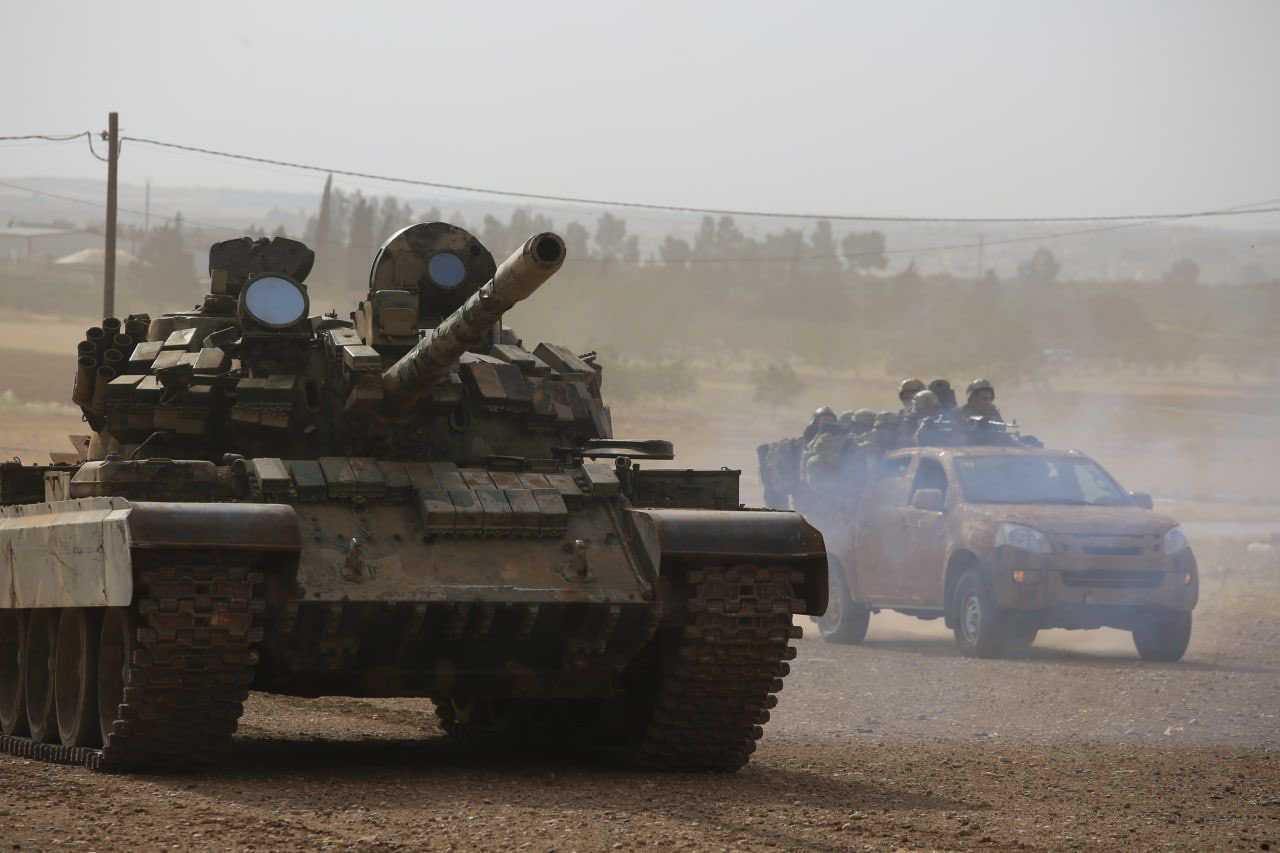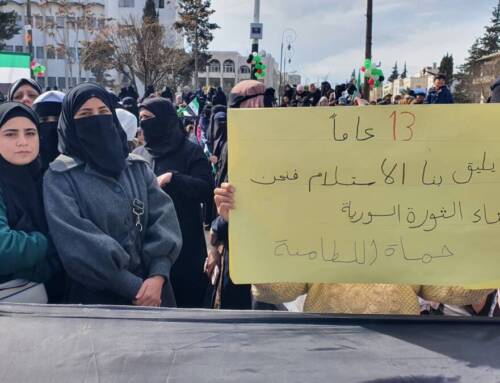Interests over ideology: Why al-Jolani is expanding into northern Aleppo, and how Turkey might respond
Hayat Tahrir al-Sham’s expansion into northern Aleppo can be explained not through ideology, but strategic interests. Whether or not the hardline faction holds on to its recently captured territory hinges on how Turkey responds.
14 October 2022
PARIS — After joining the frontline against the Turkish-backed Syrian National Army’s Third Legion, Hayat Tahrir al-Sham allied with other SNA factions and took control of Afrin city and other parts of the northern Aleppo countryside on Thursday, where it appears to be trying to establish itself as a de facto authority.
The Administration of Liberated Areas, part of the HTS-affiliated Syrian Salvation Government (SSG), toured recently captured villages and camps in the Afrin countryside alongside the SSG Directorate of Humanitarian Affairs on Friday. Images published by the Administration show SSG figures meeting with civilians and distributing bread.
On Tuesday evening, HTS—the hardline Islamist group which controls territory in Idlib and parts of the northern Hama and western Aleppo countrysides—stormed SNA-held parts of northern Aleppo alongside the SNA’s Hamza Division.
The Hamza Division, locally known as al-Hamzat, was under attack by the Third Legion after commanders and fighters in the faction were implicated in planning and carrying out the assassination of media activist Muhammad Abdul Latif (Abu Ghannoum) and his wife in al-Bab city last week.
HTS intervened after the Third Legion expelled the Hamza Division from al-Bab city and the Military College (formerly the School of Agriculture) located on the city’s outskirts, which the faction used as its main headquarters. The Third Legion also drove the Hamza Division out of headquarters in the Afrin countryside.
New alignments
In the early morning hours on Wednesday, the shapes of new open alignments in Syria’s northwest took shape. The SNA’s Sultan Suleiman Shah Division, led by the controversial commander Abu Amsha, joined the fray alongside HTS and the Hamza Division. The SNA’s 32nd Division, also known as Ahrar al-Sham–Eastern Sector, also joined the alliance. Hayat Thaeroon for Liberation, the second-largest military formation in the SNA after the Third Legion, followed suit, although not openly.
Meanwhile, Faylaq al-Sham, another SNA faction, worked to open a path for HTS forces to enter SNA territories without resistance. It was the second time the faction, which is deployed in areas adjacent to HTS-held Idlib, facilitated the latter’s passage into the northern Aleppo countryside. It acted similarly this past July, after clashes broke out between the Third Legion and Ahrar al-Sham–Eastern Sector and HTS intervened in support of the latter, but withdrew hours later.
On the other side, the Third Legion—in which al-Jabha al-Shamiya is the largest force—found itself alone in confronting the Hamza Division’s allies after HTS depleted the strength of the Eastern Army aligned with the Third Legion. HTS took over the areas where the Eastern Army was deployed in the Afrin countryside. Harakat al-Tahrir wal Binaa took a neutral stance and handed over their areas and the al-Hamam border crossing with Turkey in exchange for a safe exit for its forces.
As HTS and its allies took control of Afrin city, the Jenderes district and their surrounding areas, the Third Legion withdrew towards Azaz city, al-Jabha al-Shamiya’s main stronghold. Jaish al-Islam, also part of the Third Legion, concentrated itself farther east, in al-Bab city.
So far, HTS has only taken control of “some places that belong to us,” the director of the Third Legion’s press office, Sirajuddin al-Omar, told Syria Direct. He said most areas HTS has advanced to were not controlled by the Third Legion, “but mainly belong to al-Hamzat, al-Amshat [the nickname for the Sultan Suleiman Shah Division] and Thaeroon.”
As the Third Legion falls back to areas it controls in Azaz, al-Bab, Kafr Jana and Qatmah, “resistance is more effective, since these are our areas of influence,” al-Omar said.
“Opening fronts against the Third Legion from Afrin to al-Bab and Jarablus makes direct confrontation more difficult,” an administrative source in the SNA told Syria Direct. “So it has decided to fortify itself in its centers of influence until some agreement is reached.”
Under the current conditions, “the Third Legion cannot confront or hold out for long against HTS,” a political science researcher in Turkey told Syria Direct, requesting anonymity for security reasons. “SNA factions overall do not have experience fighting HTS. Those with this experience are groups from Jaish al-Islam, the Eastern Army and groups from the western Aleppo countryside and Jabal al-Zawiya,” he added. However, those formations are “small, and not unified within a single entity enabling them to hold out.”
So far, it appears “the military reality favors HTS,” the researcher said. “It is moving with a strategy the factions don’t have, and the latter also don’t have a doctrine or armaments that are sufficient to face HTS.”
What does al-Jolani want?
The quick acceleration of military operations between the battling factions in northwestern Syria this week reveals that “everybody was preparing for the confrontation, and Abu Ghannoum’s murder and the disclosure of the perpetrators only sparked the clashes, which had been prepared for months,” said Wael Alwan, a researcher at the Turkey-based Jusoor Center for Studies.
The clashes may have started between the Hamza Division and the Third Legion, but the real conflict is between the Third Legion and HTS. It is “a conflict for existence, not for extension and influence,” Alwan said. As he sees it, Abu Muhammad al-Jolani, the commander of HTS, is supporting the Hamza Division to “turn it and Abu Amsha’s faction into a powerful bloc with parallel strength to the Third Legion.”
Such a bloc would bring al-Jolani “significant economic gains, by striking a new balance” in the northern Aleppo countryside, “so he would have strong partners in wide sectors,” Alwan said. It would also benefit those who are part of it, as without al-Jolani’s support “the combined strength of al-Hamzat and al-Amshat cannot be compared to the strength of the Third Legion, which is why al-Jolani is trying to bolster his partners’ strength.”
Al-Jolani’s latest moves come after he “succeeded in controlling his space of influence in Idlib, by suppressing the movements of his adversaries and the factions present there, and controlling the civilian scene through the SSG,” the political researcher in Turkey explained. This success prompted him to “aspire to redraw the map in northern Aleppo through a number of tools, including al-Hamzat,” he added.
Over the past months, HTS used a range of diplomatic and military tools to pave the way for its entry into northern Aleppo. It “sent military leaders and economic officials to meet with SNA leaders, allowed some of the latter’s factions to establish military points under its watch on the lines of fire with the regime in [HTS] areas in the western Aleppo countryside and planted its agents in SNA areas,” the researcher said.
An HTS alliance with al-Hamzat and al-Amshat, groups with no clear ideology compared to Salafi-jihadist HTS, serves as “a means and tool to achieve HTS goals,” the researcher explained. HTS has long “accused its two allies today of unbelief and collaboration,” he added.
Although HTS has come a long way towards achieving its goals in the Aleppo countryside, it is not yet possible to sketch out what type of presence the faction wants in the area. Its final shape depends on multiple factors, including “the stance of the local people, especially since the northern Aleppo countryside includes a large number of those opposed to and wanted by HTS,” the researcher said. And, perhaps most importantly, it depends on “Turkey’s stance on this expansion,” which remains unclear.
Is Ankara breaking its silence?
So far, Ankara has not shown any position towards the ongoing infighting between the SNA factions it supports, and which are stationed in its areas of influence in northern Syria. Nor has Turkey taken any military measures to prevent HTS from entering Afrin.
But Alwan expects Ankara to step in, as it has before, “to stop the conflict and force HTS to withdraw from SNA areas after [facilitating] a settlement between the conflicting SNA factions.”
The other researcher agreed that “Turkey’s role will be decisive,” but added that Ankara’s delay in intervening is in its interest. “Their top man, Abu Amsha, is the one fighting alongside al-Jolani,” he said.
“Turkey seeks to trim al-Jabha al-Shamiya’s claws and set limits for it, but because it does not want to intervene directly and openly against major factions such as al-Shamiya and HTS, it prefers these two forces collide with one another, to teach al-Jabha al-Shamiya a lesson on one hand, and cause HTS to fall into a serious mistake on the other,” the researcher said. “HTS entering the Aleppo countryside may be bait for [Turkey] to reassert its control.”
“The Turks understand that al-Jolani is not a useful alternative for them,” the researcher said, “because his presence could disrupt any form of understanding with the Syrian regime, and will be an argument against Turkey for the regime and the Russians.”
Current military developments, as well as field visits by SSG figures to Afrin, indicate that HTS is committed to both maintaining the new territories it has expanded into and continuing military support in the Aleppo countryside.
But “the scenario of al-Jolani advancing beyond Afrin won’t be easy for him,” Alwan said. Current HTS strategy “is to weaken the Third Legion and its allies while strengthening their enemies, and then withdraw,” he said. “This is based on the exchange of both security and economic interests.”
HTS’ opportunity to expand in northern Aleppo is ruled by three factors, the other researcher said: “Turkey’s stance, the factions’ capacity to form an anti-HTS front and public opinion.” The latter “played a large role in strengthening resistance to HTS and the Islamic State previously, but today civilians have lost trust in the factions, and feel they are paying the highest tax.”
Even if HTS is forced to withdraw from SNA areas of Aleppo this time, it will not end “al-Jolani’s ambition to control all this geography,” the researcher said. The question remains: “Will Ankara allow that?”
**
This report was originally published in Arabic and translated into English by Mateo Nelson.







